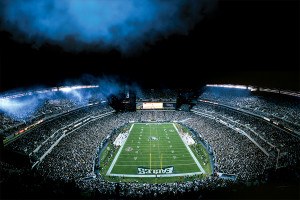Home: Bay Window
The Philadelphia businessman has lived all over the world, but he remembers exactly where he was standing four years ago when he first saw this particular view. He had come around the right side of the house, walked through the wooden door leading to the rear deck and voilà — the vista unfurled.
There were emerald-green reeds growing skyward to create a natural railing at the edge of the deck, and past the silky reeds, Barnegat Bay stretched far into the distance.
The houses on the northwestern edge of the inlet were faint outlines, and farther north, Barnegat Lighthouse stood tall. “It’s not the newest house, or the biggest house,” the owner recalls thinking. “But the view sold me immediately.”
When Philadelphia interior designer Meg Rodgers, owner of Marguerite Rodgers Ltd., drove to Long Beach Island to take a look, she saw that the interior didn’t quite measure up to that spectacular view. The home’s large main room, where the kitchen, dining and living areas flow into one another, was overpowered by white-laminate built-in cubbies, cupboards and a kitchen island circa 1980, the year the house was built.
These synthetic materials were at odds with the natural beauty of the surroundings. “The landscape has a Japanese sensibility,” Rodgers says. “There’s an ethereal feel to the bay. It’s very calming.”
Rodgers thought about bringing the Asian aesthetic inside. The existing vocabulary of the place egged her on. The building is low-slung, and the rooms are modestly proportioned. The sliding-glass doors that ran the circumference of the place did a nice job of integrating the indoor and outdoor spaces. The owner was immediately on board with his designer’s vision for a look that would echo the tranquility of the bay and focus on natural materials.
He liked that her plan paid homage to the place’s intimacy and human scale, but he planned to use his vacation home for entertaining, so he also wanted lots of seating and guest quarters that felt comfortable and private. To up the square footage, Rodgers and architect Bob Torres, owner of Philadelphia-based Studio Torres, pushed the exterior walls out 18 inches, getting rid of a skinny ledge that had circled the building, and attached another room — a multifunctional screened porch — to the guest wing.
During an early visit, Rodgers noticed that, from the slightly elevated railed walkway in the living room, she had to stoop to look through the glass doors facing the bay. To make it easier to take in the landscape, she and Torres extended the glass doors and windows by nearly 2 feet. Interior shutters allow light to come in while lending privacy to the deck off the master bedroom and to the guest rooms.
The extra wall space also makes more room for the owner’s art collection. Throughout the house and on the veranda and deck are vases and other Asian antiques, including a Japanese stone lantern from Philadelphia’s Liao Collection Asian Antiques. The chest-high vessels outside are filled with towering bamboo throughout the summer. Most of the pieces were handpicked by the owner, who sent Rodgers photos of the artwork and of his Oriental rugs as reference points for her design.
The two traded photos throughout the process. Rodgers wanted the homeowner to approve everything she bought so the design would reflect his interests and lifestyle. “It needs to have the spirit of the owner, or it would feel too impersonal,” she says.
But she also guided the selection by bringing choices to his attention, like some Nakashima lots that were coming up for sale at Freeman’s Auction House in Philadelphia. He ended up buying, among other pieces, two living room chairs, a small table for the bedroom, several shelves and a cabinet that hangs on the living room wall.
The rich natural luster of the Nakashima furniture, the walnut flooring, and the kitchen cabinetry that evokes traditional Japanese tansu chests with its horizontal lines, creates a neutral, earthy backdrop that plays off the beachy palette of sandy whites and taupes that Rodgers used for the walls and textiles. The red, orange and yellow striped carpet in one guest room, across a short hallway from the front door, is one of only a few spots of bright color. “Color is wonderful in a summer place,” says Rodgers. “We weren’t doing color anywhere else, so to maximize the impact, the first room you see when you come in is very warm.”
It would have been easy to ruin the beach-house effect with technology — speakers, enormous TVs, electronics and everything else that makes living there a breeze — but Rodgers concealed the house’s modern amenities. A Bang & Olufsen 42-inch plasma TV sleeps behind a custom-made split-bamboo panel atop the fireplace. The stereo system, TV and DVD controls are manipulated by a sleek, black remote unit the size of an Xbox controller.
Lighting designer Sean O’Connor, principal of Sean O’Connor Associates in Philadelphia, developed a minimalist lighting scheme using small, subtle fixtures recessed and integrated in the ceiling to keep the focus on what is illuminated instead of on the light sources themselves. A small black panel near the front door controls the lighting according to five preset “scenes.” The “welcome” scene is bright; “entertaining” highlights the dining table and some artwork; and “audiovisual” darkens the area in front of the TV.
During the day, hardly any electric lights are needed, as the house is flooded with natural light, the truest expression of a design that’s infused by the character of the landscape. And on either side of the flat-screen TV are expanses of glass through which plays out the most spectacular show: the bay’s ecosystem. The owner, who’s been crazy about birds since he was a child, can rattle off the creatures he’s spotted through his binoculars — kingfishers, blue herons, roving egrets, ospreys. And though he’s thrilled by the way the house has turned out, the highlight for him is still the view. “When I came out here in the winter, after closing on the house, the reeds were all brown. I was so worried they weren’t going to come back green, but they did,” he says, amazed, “and they continue to, every summer.”


